Why Are Trees Important?
Have you ever heard this proverb? - “The best time to plant a tree was 20 years ago. The second-best time is now.”
These wise words highlight how valuable trees are to us! They provide shade and cool our cities, making them pleasant and beautiful places to live, work and play. Trees also provide privacy and wind breaks and reduce water runoff, erosion, dust, and air pollution. They also save us money on our energy bills when they shade buildings and use water more efficiently than lawns. You could say they are our most important landscape investment, whether they were planted 20 years ago or today!
That’s why it’s so important to protect and promote healthy landscape trees, and one of the key ways we can do that is with proper irrigation. Keep reading to find out the basics of tree irrigation and how to keep these valuable assets healthy and pest free.
The key points we will cover include:
• How do trees take up water?
• What is the most efficient irrigation for trees?
• How much water do trees need?
• How often and how long should you water your trees?
How Trees Take Up Water
When people think about watering trees, they commonly think it starts in the roots. But, surprise – it actually starts in the leaves!
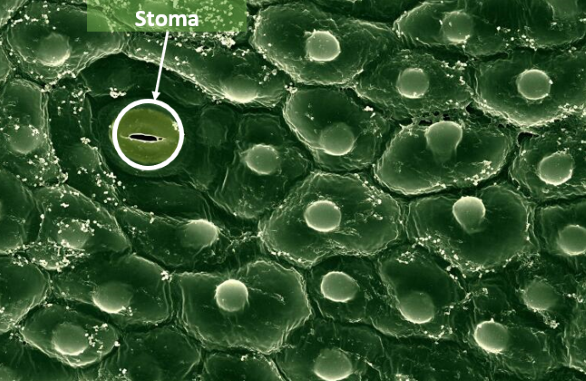
An open stoma located on the lower surface of an orchid leaf circled in white. Photo Credit: Lauren Holden (CC by 4.0)
Transpiration, or water movement through plants, begins at the leaf surface from microscopic openings called stoma, which are similar to pores in our skin. As water evaporates from these openings, capillary action pulls water molecules from below. This suction pulls water up from the roots, just like drinking from a straw.
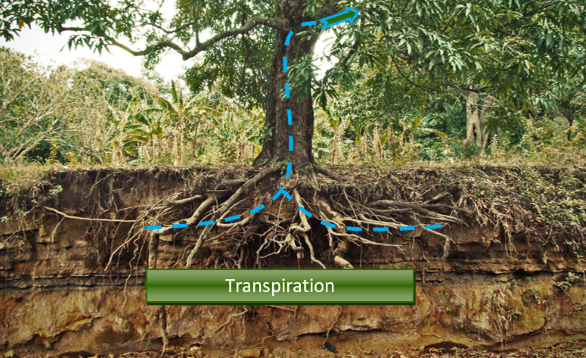 Transpiration pulls water up from the roots to the tree canopy, where it is lost through tiny leaf pores. Photo Credit: https://aplustree.com"
Transpiration pulls water up from the roots to the tree canopy, where it is lost through tiny leaf pores. Photo Credit: https://aplustree.com"
So now that you understand how trees suck up water, let’s talk about the roots. Helping your landscape trees thrive begins with knowing where the water-absorbing roots are located. They are concentrated in the top 2 feet of soil and extend out to the edge of the tree’s canopy (also called drip line) and beyond. There are NO water-absorbing roots within 6 inches of the trunk.
What is the Most Effective Irrigation for Healthy Trees?
Drip irrigation is the most effective and efficient way to water most of the tree’s critical root zone. We prefer inline drip irrigation tubing with pressure-compensating emitters, placed on top of the soil and covered with a layer of organic mulch. This type of tubing is less prone to rodent damage and reduces the labor needed to hand-install hundreds of emitters. The inline drip tubing should be installed in circles around the tree to cover the entire critical root zone.
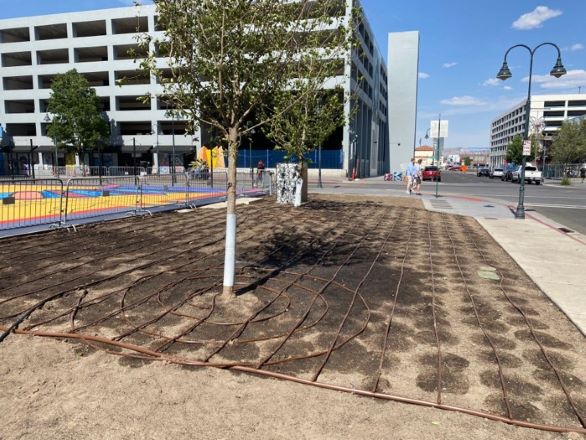 Circularly arranged inline drip tubing in an urban tree planter with properly spaced emitters that provide water to most of the trees’ water-absorbing roots. In addition to the circular pattern around the trees a second “grid” irrigation system was placed to water perennial flowers that will be planted later. Photo Credit: Matt Basile, Urban Forester, City of Reno
Circularly arranged inline drip tubing in an urban tree planter with properly spaced emitters that provide water to most of the trees’ water-absorbing roots. In addition to the circular pattern around the trees a second “grid” irrigation system was placed to water perennial flowers that will be planted later. Photo Credit: Matt Basile, Urban Forester, City of Reno
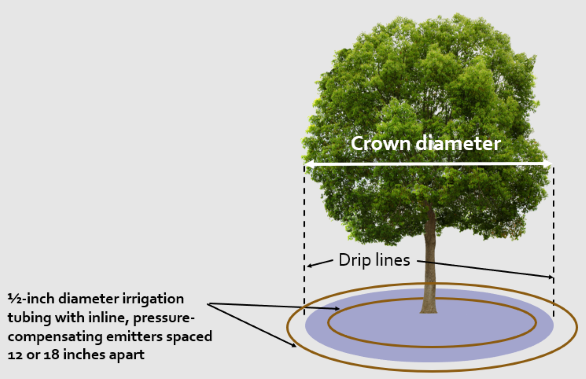 The tree’s critical root zone (shown in blue) is the area within the tree’s drip line. Inline drip tubing should cover 60% to 75% of the critical root zone.
The tree’s critical root zone (shown in blue) is the area within the tree’s drip line. Inline drip tubing should cover 60% to 75% of the critical root zone.
Number of Emitters in Drip Tubing with Different Emitter Spacing
Inline drip tubing has emitters pre-installed at various spacings: 18-inch spacing and 12-inch spacing are common. This chart shows how many emitters are available in tubing of different lengths.
| 1/2- inch inline tubing length |
18-inch emitter spacing |
12-inch emitter spacing |
| 200 feet |
133 emitters |
200 emitters |
| 100 feet |
66 emitters |
100 emitters |
| 50 feet |
33 emitters |
50 emitters |
The emitter spacing you need depends on your soil type. In sandy soils the emitters should be spaced closer together (12 inches apart) because water drains more quickly in sandy soils. In clay soils the emitters should be spaced 18 inches apart because water moves laterally more quickly in these soils.
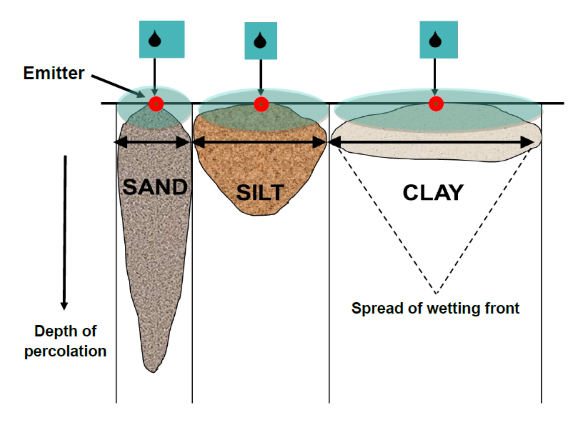
How Much Water?
Evapotranspiration (ET) is a combination of the water lost from transpiration through plants and the water lost from evaporation from the ground. How much water a tree will need is the difference between evapotranspiration and precipitation. Precipitation falls as rain or snow. ET and precipitation are measured in inches. The graph below shows the great disparity between ET and precipitation during the summertime, when trees need water the most. This means if you don’t provide enough irrigation, your tree will fail!
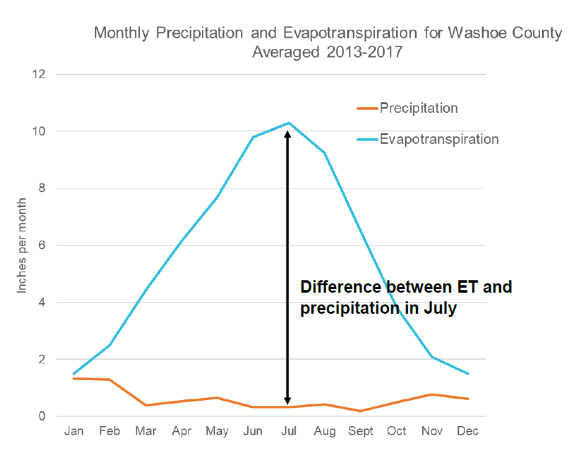
The U.S. Environmental Protection Agency (EPA) provides peak month ET data for each zip code in the United States (http://www.epa.gov/watersense/water-budget-data-finder). You can use this data and calculate tree water needs in gallons per week using the calculations in the Tree Irrigation Handbook (download at bottom of this page). Or, for a quick reference, we’ve done the math for different size trees that are high and low water use in northern Nevada below. High water use trees include birch and spruce. Low water use trees include hackberry and oak.
Gallons of Water Per Week (Northern Nevada)
| Diameter of root zone in feet |
8 |
10 |
15 |
20 |
25 |
30 |
| Gallons of water for low water use tree |
34 |
53 |
119 |
212 |
332 |
478 |
| Gallons of water for high water use tree |
54 |
85 |
191 |
340 |
531 |
764 |
Calculations based on peak month ET of 9.32 inches. Divide peak month ET by 4.3 to get a weekly ET of 2.17 inches.
Gallons of Water Per Week (Southern Nevada)
| Diameter of root zone in feet |
8 |
10 |
15 |
20 |
25 |
30 |
| Gallons of water for low water use tree |
52 |
81 |
183 |
325 |
508 |
731 |
| Gallons of water for high water use tree |
83 |
130 |
292 |
520 |
812 |
1,170 |
Calculations based on peak month ET of 14.27 inches. Divide peak month ET by 4.3 to get a weekly ET of 3.32 inches.
How Often and How Long Should I Run the Irrigation System?
Trees should be watered deeply and less frequently than lawns and perennial shrubs. While lawns should be watered to a depth of 6 to 8 inches 3 days per week in the summer, trees should only be watered every 1 to 2 weeks to a depth of 18 to 24 inches. The chart below shows suggested watering depth and frequency for most of the growing season in northern Nevada, but note that you may need to adjust it depending on air temperature. At temperatures above 100 degrees F, trees may require water twice a week.
Recommended Watering Depth and Frequency
| Plant Type |
Watering Depth |
Watering Frequency |
| Mature trees |
18 to 24 inches |
Every 1 to 2 weeks |
| Shrubs and perennials |
12 to 18 inches |
2 or 3 days per week |
| Annuals |
8 to 12 inches |
3 days per week |
| Turfgrass lawns |
6 to 8 inches |
3 days per week |
You must consider the number of drip emitters you have and their flow rate to determine how long to run your system to supply the amount of water your tree needs. We explain the math in the downloadable Tree Irrigation Handbook (link at bottom of page), but for quick reference, we’ve done the math for you here. The chart below shows suggested weekly run times for individual LOW-water-use trees of different sizes using different emitter flow rates and spacing. These run times are calculated for the hottest time of the year. Irrigate less often during cooler times of the year.
Weekly Irrigation Run Times for Northern Nevada
| Size of Tree |
Clayey Soil with 0.6 gph emitters at 18 inches apart |
Sandy soil with 0.9 gph emitters at 12 inches apart |
| Large tree |
133 emitters for 5 hours |
200 emitters for 2.25 hours |
| Medium tree |
66 emitters for 4.2 hours |
100 emitters for 1.8 hours |
| Small Tree |
33 emitters for 2.25 hours |
50 emitters for 1 hour |
Weekly Irrigation Run Times for Southern Nevada
| Size of Tree |
Clayey Soil with 0.6 gph emitters at 18 inches apart |
Sandy soil with 0.9 gph emitters at 12 inches apart |
| Large tree |
133 emitters for 7.75 hours |
200 emitters for 3.45 hours |
| Medium tree |
66 emitters for 6.4 hours |
100 emitters for 2.8 hours |
| Small Tree |
33 emitters for 3.4 hours |
50 emitters for 1.5 hour |
Tree Irrigation Recap
While irrigation can seem very complicated, we hope you now understand these main concepts:
• Trees are valuable.
• Proper irrigation promotes healthy trees and reduces pests and disease.
• You should irrigate the entire area of water-absorbing roots.
• Inline drip tubing with pressure-compensating emitters last longer and save time.
• The amount of water to apply is the difference between ET and precipitation.
• Trees need weekly deep watering in the summer months.
Download the Tree Irrigation Handbook PDF version using the link below.


